1997 MERCEDES-BENZ ML350 light
[x] Cancel search: lightPage 1545 of 4133
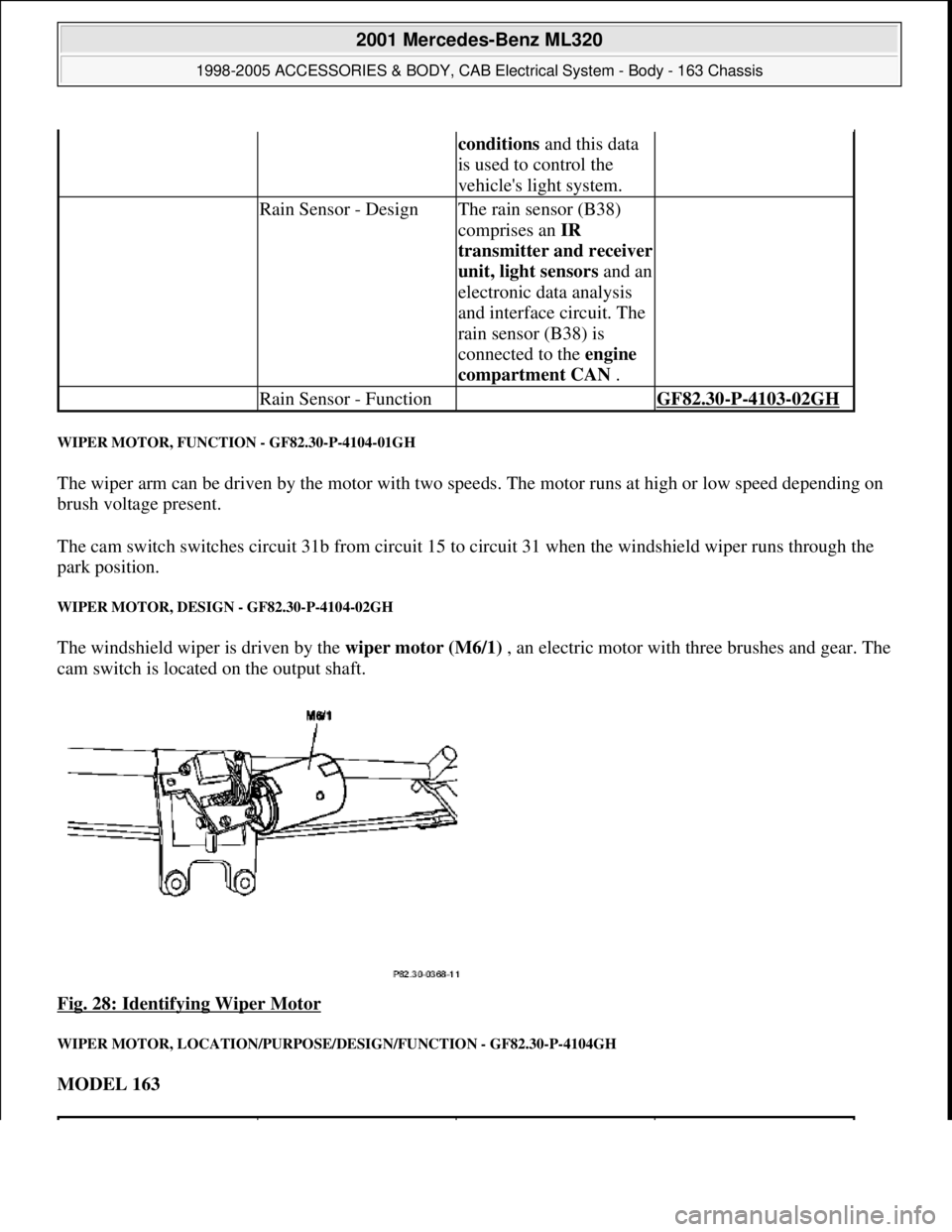
WIPER MOTOR, FUNCTION - GF82.30-P-4104-01GH
The wiper arm can be driven by the motor with two speeds. The motor runs at high or low speed depending on
brush voltage present.
The cam switch switches circuit 31b from circuit 15 to circuit 31 when the windshield wiper runs through the
park position.
WIPER MOTOR, DESIGN - GF82.30-P-4104-02GH
The windshield wiper is driven by the wiper motor (M6/1) , an electric motor with three brushes and gear. The
cam switch is located on the output shaft.
Fig. 28: Identifying Wiper Motor
WIPER MOTOR, LOCATION/PURPOSE/DESIGN/FUNCTION - GF82.30-P-4104GH
MODEL 163
conditions and this data
is used to control the
vehicle's light system.
Rain Sensor - DesignThe rain sensor (B38)
comprises an IR
transmitter and receiver
unit, light sensorsand an
electronic data analysis
and interface circuit. The
rain sensor (B38) is
connected to the engine
compartment CAN .
Rain Sensor - Function GF82.30-P-4103-02GH
2001 Mercedes-Benz ML320
1998-2005 ACCESSORIES & BODY, CAB Electrical System - Body - 163 Chassis
me
Saturday, October 02, 2010 3:30:05 PMPage 50 © 2006 Mitchell Repair Information Company, LLC.
Page 1566 of 4133
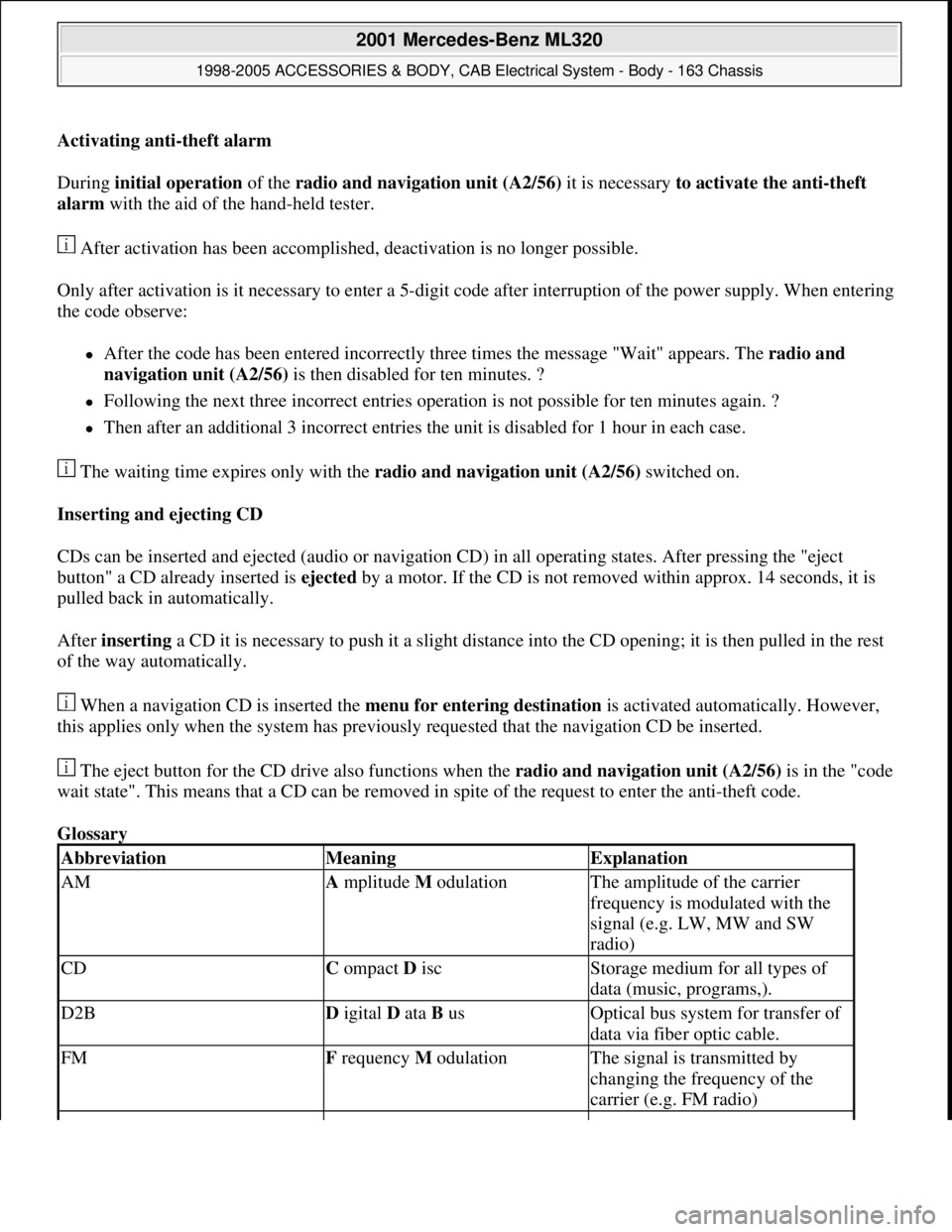
Activating anti-theft alarm
During initial operation of the radio and navigation unit (A2/56) it is necessary to activate the anti-theft
alarm with the aid of the hand-held tester.
After activation has been accomplished, deactivation is no longer possible.
Only after activation is it necessary to enter a 5-digit code after interruption of the power supply. When entering
the code observe:
After the code has been entered incorrectly three times the message "Wait" appears. The radio and
navigation unit (A2/56) is then disabled for ten minutes. ?
Following the next three incorrect entries operation is not possible for ten minutes again. ?
Then after an additional 3 incorrect entries the unit is disabled for 1 hour in each case.
The waiting time expires only with the radio and navigation unit (A2/56) switched on.
Inserting and ejecting CD
CDs can be inserted and ejected (audio or navigation CD) in all operating states. After pressing the "eject
button" a CD already inserted is ejected by a motor. If the CD is not removed within approx. 14 seconds, it is
pulled back in automatically.
After inserting a CD it is necessary to push it a slight distance into the CD opening; it is then pulled in the rest
of the way automatically.
When a navigation CD is inserted the menu for entering destination is activated automatically. However,
this applies only when the system has previously requested that the navigation CD be inserted.
The eject button for the CD drive also functions when the radio and navigation unit (A2/56)is in the "code
wait state". This means that a CD can be removed in spite of the request to enter the anti-theft code.
Glossary
AbbreviationMeaningExplanation
AMA mplitude M odulationThe amplitude of the carrier
frequency is modulated with the
signal (e.g. LW, MW and SW
radio)
CDC ompact D iscStorage medium for all types of
data (music, programs,).
D2BD igital D ata B usOptical bus system for transfer of
data via fiber optic cable.
FMF requency M odulationThe signal is transmitted by
changing the frequency of the
carrier (e.g. FM radio)
2001 Mercedes-Benz ML320
1998-2005 ACCESSORIES & BODY, CAB Electrical System - Body - 163 Chassis
me
Saturday, October 02, 2010 3:30:05 PMPage 71 © 2006 Mitchell Repair Information Company, LLC.
Page 1589 of 4133
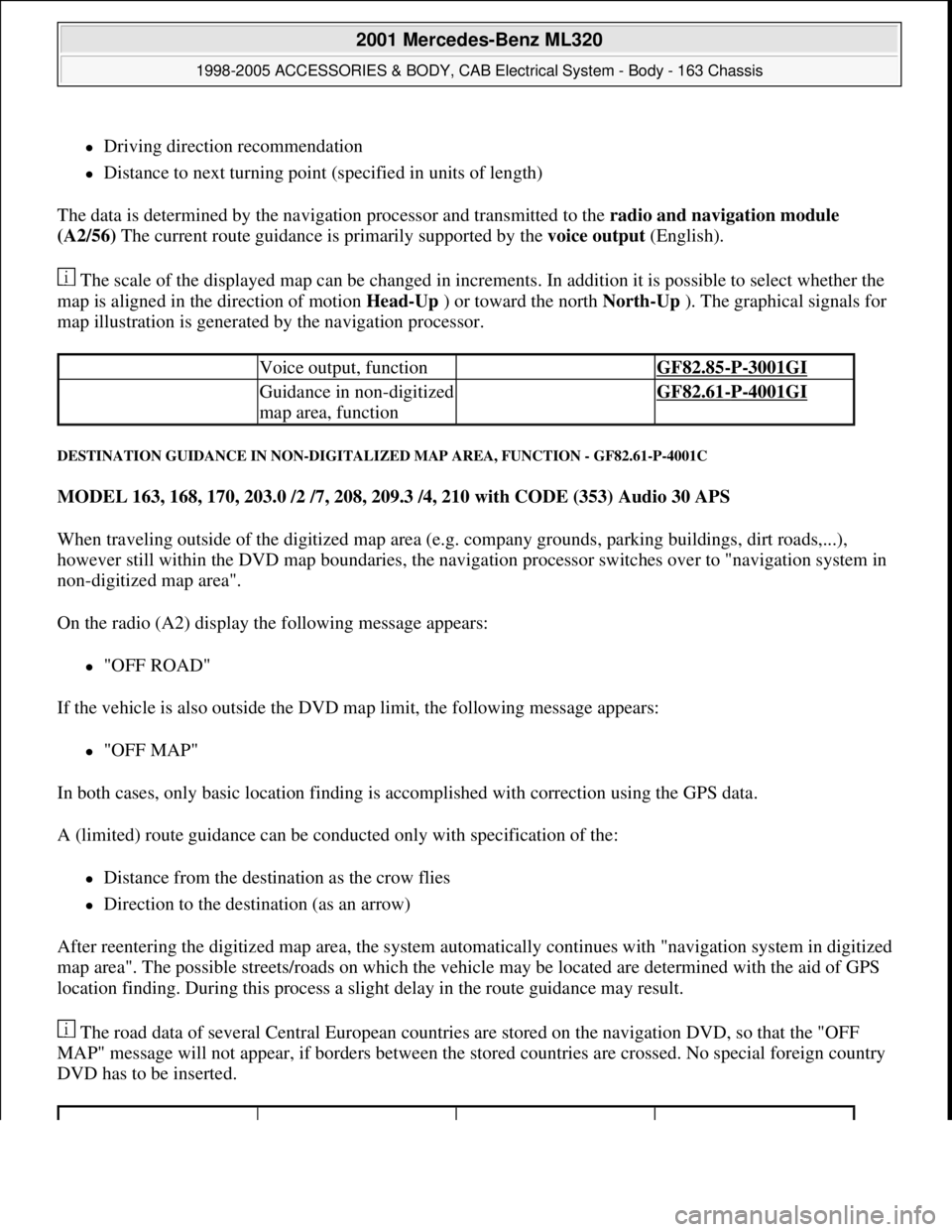
Driving direction recommendation
Distance to next turning point (specified in units of length)
The data is determined by the navigation processor and transmitted to the radio and navigation module
(A2/56) The current route guidance is primarily supported by the voice output (English).
The scale of the displayed map can be changed in increments. In addition it is possible to select whether the
map is aligned in the direction of motion Head-Up ) or toward the north North-Up ). The graphical signals for
map illustration is generated by the navigation processor.
DESTINATION GUIDANCE IN NON-DIGITALIZED MAP AREA, FUNCTION - GF82.61-P-4001C
MODEL 163, 168, 170, 203.0 /2 /7, 208, 209.3 /4, 210 with CODE (353) Audio 30 APS
When traveling outside of the digitized map area (e.g. company grounds, parking buildings, dirt roads,...),
however still within the DVD map boundaries, the navigation processor switches over to "navigation system in
non-digitized map area".
On the radio (A2) display the following message appears:
"OFF ROAD"
If the vehicle is also outside the DVD map limit, the following message appears:
"OFF MAP"
In both cases, only basic location finding is accomplished with correction using the GPS data.
A (limited) route guidance can be conducted only with specification of the:
Distance from the destination as the crow flies
Direction to the destination (as an arrow)
After reentering the digitized map area, the system automatically continues with "navigation system in digitized
map area". The possible streets/roads on which the vehicle may be located are determined with the aid of GPS
location finding. During this process a slight delay in the route guidance may result.
The road data of several Central European countries are stored on the navigation DVD, so that the "OFF
MAP" message will not appear, if borders between the stored countries are crossed. No special foreign country
DVD has to be inserted.
Voice output, function GF82.85-P-3001GI
Guidance in non-digitized
map area, function GF82.61-P-4001GI
2001 Mercedes-Benz ML320
1998-2005 ACCESSORIES & BODY, CAB Electrical System - Body - 163 Chassis
me
Saturday, October 02, 2010 3:30:05 PMPage 94 © 2006 Mitchell Repair Information Company, LLC.
Page 1640 of 4133
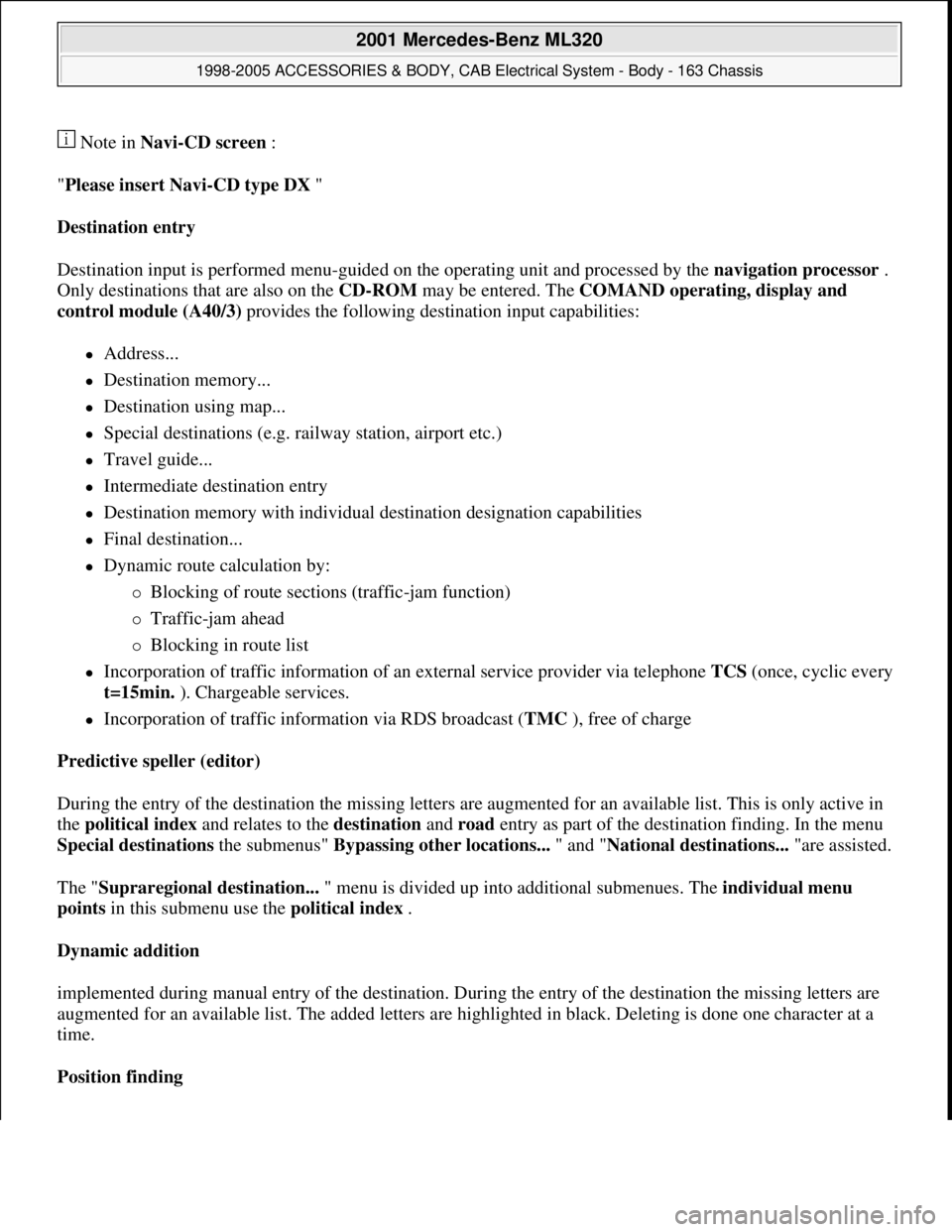
Note in Navi-CD screen :
"Please insert Navi-CD type DX "
Destination entry
Destination input is performed menu-guided on the operating unit and processed by the navigation processor .
Only destinations that are also on the CD-ROM may be entered. The COMAND operating, display and
control module (A40/3) provides the following destination input capabilities:
Address...
Destination memory...
Destination using map...
Special destinations (e.g. railway station, airport etc.)
Travel guide...
Intermediate destination entry
Destination memory with individual destination designation capabilities
Final destination...
Dynamic route calculation by:
Blocking of route sections (traffic-jam function)
Traffic-jam ahead
Blocking in route list
Incorporation of traffic information of an external service provider via telephone TCS (once, cyclic every
t=15min. ). Chargeable services.
Incorporation of traffic information via RDS broadcast (TMC ), free of charge
Predictive speller (editor)
During the entry of the destination the missing letters are augmented for an available list. This is only active in
the political index and relates to the destination and road entry as part of the destination finding. In the menu
Special destinations the submenus" Bypassing other locations... " and "National destinations... "are assisted.
The "Supraregional destination... " menu is divided up into additional submenues. The individual menu
points in this submenu use the political index .
Dynamic addition
implemented during manual entry of the destination. During the entry of the destination the missing letters are
augmented for an available list. The added letters are highlighted in black. Deleting is done one character at a
time.
Position finding
2001 Mercedes-Benz ML320
1998-2005 ACCESSORIES & BODY, CAB Electrical System - Body - 163 Chassis
me
Saturday, October 02, 2010 3:30:06 PMPage 145 © 2006 Mitchell Repair Information Company, LLC.
Page 1657 of 4133
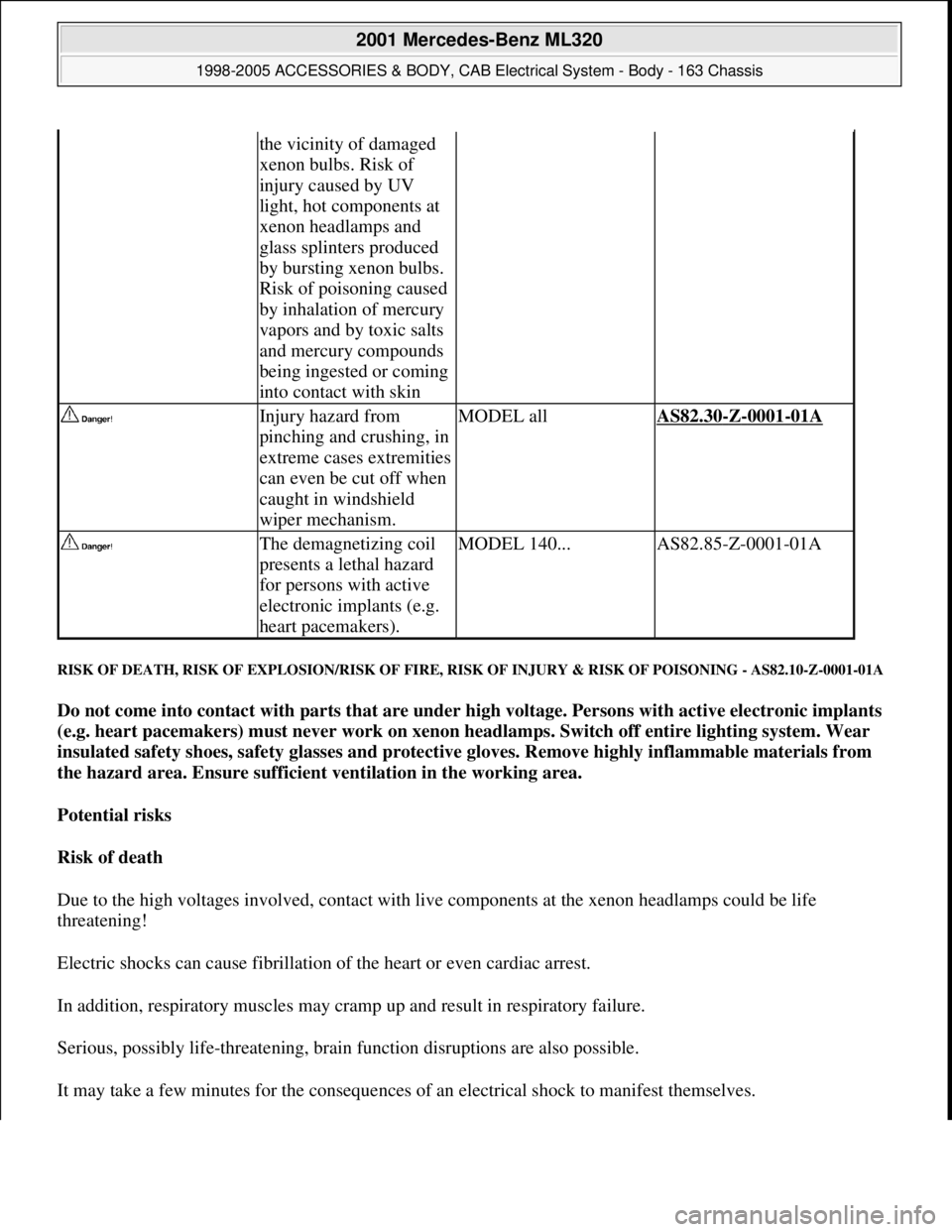
RISK OF DEATH, RISK OF EXPLOSION/RISK OF FIRE, RISK OF INJURY & RISK OF POISONING - AS82.10-Z-0001-01A
Do not come into contact with parts that are under high voltage. Persons with active electronic implants
(e.g. heart pacemakers) must never work on xenon headlamps. Switch off entire lighting system. Wear
insulated safety shoes, safety glasses and protective gloves. Remove highly inflammable materials from
the hazard area. Ensure sufficient ventilation in the working area.
Potential risks
Risk of death
Due to the high voltages involved, contact with live components at the xenon headlamps could be life
threatening!
Electric shocks can cause fibrillation of the heart or even cardiac arrest.
In addition, respiratory muscles may cramp up and result in respiratory failure.
Serious, possibly life-threatening, brain function disruptions are also possible.
It ma
y take a few minutes for the consequences of an electrical shock to manifest themselves.
the vicinity of damaged
xenon bulbs. Risk of
injury caused by UV
light, hot components at
xenon headlamps and
glass splinters produced
by bursting xenon bulbs.
Risk of poisoning caused
by inhalation of mercury
vapors and by toxic salts
and mercury compounds
being ingested or coming
into contact with skin
Injury hazard from
pinching and crushing, in
extreme cases extremities
can even be cut off when
caught in windshield
wiper mechanism.MODEL allAS82.30-Z-0001-01A
The demagnetizing coil
presents a lethal hazard
for persons with active
electronic implants (e.g.
heart pacemakers).MODEL 140...AS82.85-Z-0001-01A
2001 Mercedes-Benz ML320
1998-2005 ACCESSORIES & BODY, CAB Electrical System - Body - 163 Chassis
me
Saturday, October 02, 2010 3:30:06 PMPage 162 © 2006 Mitchell Repair Information Company, LLC.
Page 1658 of 4133
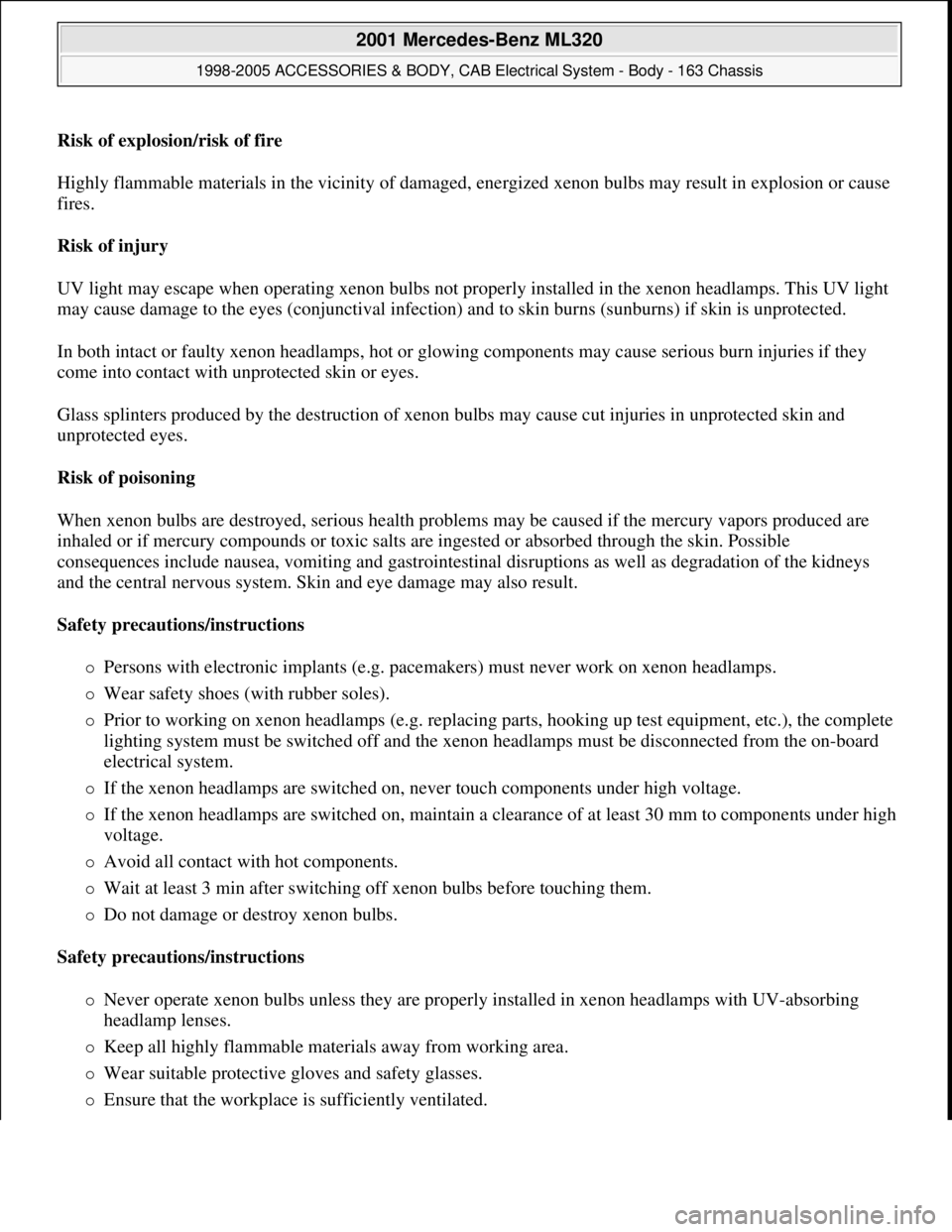
Risk of explosion/risk of fire
Highly flammable materials in the vicinity of damaged, energized xenon bulbs may result in explosion or cause
fires.
Risk of injury
UV light may escape when operating xenon bulbs not properly installed in the xenon headlamps. This UV light
may cause damage to the eyes (conjunctival infection) and to skin burns (sunburns) if skin is unprotected.
In both intact or faulty xenon headlamps, hot or glowing components may cause serious burn injuries if they
come into contact with unprotected skin or eyes.
Glass splinters produced by the destruction of xenon bulbs may cause cut injuries in unprotected skin and
unprotected eyes.
Risk of poisoning
When xenon bulbs are destroyed, serious health problems may be caused if the mercury vapors produced are
inhaled or if mercury compounds or toxic salts are ingested or absorbed through the skin. Possible
consequences include nausea, vomiting and gastrointestinal disruptions as well as degradation of the kidneys
and the central nervous system. Skin and eye damage may also result.
Safety precautions/instructions
Persons with electronic implants (e.g. pacemakers) must never work on xenon headlamps.
Wear safety shoes (with rubber soles).
Prior to working on xenon headlamps (e.g. replacing parts, hooking up test equipment, etc.), the complete
lighting system must be switched off and the xenon headlamps must be disconnected from the on-board
electrical system.
If the xenon headlamps are switched on, never touch components under high voltage.
If the xenon headlamps are switched on, maintain a clearance of at least 30 mm to components under high
voltage.
Avoid all contact with hot components.
Wait at least 3 min after switching off xenon bulbs before touching them.
Do not damage or destroy xenon bulbs.
Safety precautions/instructions
Never operate xenon bulbs unless they are properly installed in xenon headlamps with UV-absorbing
headlamp lenses.
Keep all highly flammable materials away from working area.
Wear suitable protective gloves and safety glasses.
Ensure that the workplace is sufficiently ventilated.
2001 Mercedes-Benz ML320
1998-2005 ACCESSORIES & BODY, CAB Electrical System - Body - 163 Chassis
me
Saturday, October 02, 2010 3:30:06 PMPage 163 © 2006 Mitchell Repair Information Company, LLC.
Page 1659 of 4133
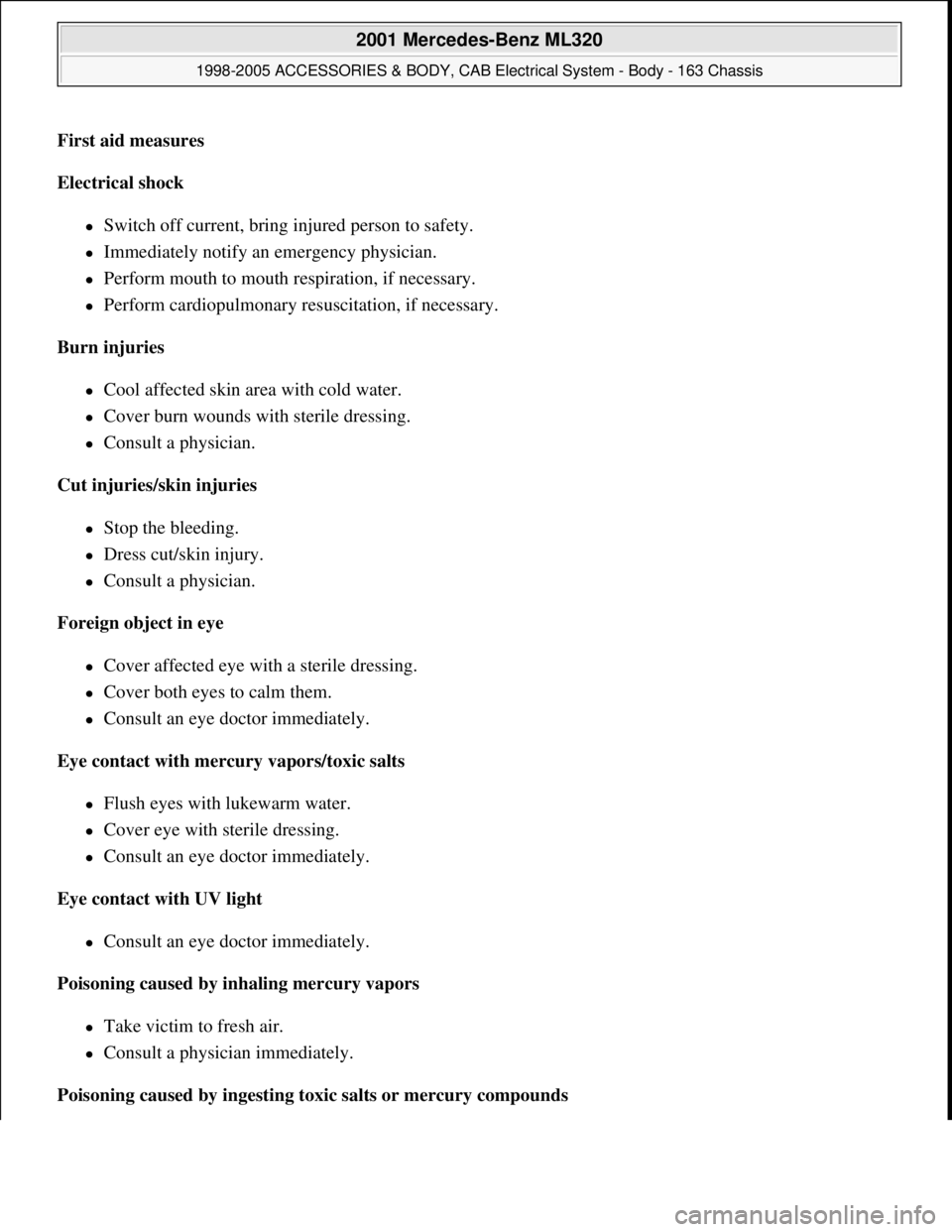
First aid measures
Electrical shock
Switch off current, bring injured person to safety.
Immediately notify an emergency physician.
Perform mouth to mouth respiration, if necessary.
Perform cardiopulmonary resuscitation, if necessary.
Burn injuries
Cool affected skin area with cold water.
Cover burn wounds with sterile dressing.
Consult a physician.
Cut injuries/skin injuries
Stop the bleeding.
Dress cut/skin injury.
Consult a physician.
Foreign object in eye
Cover affected eye with a sterile dressing.
Cover both eyes to calm them.
Consult an eye doctor immediately.
Eye contact with mercury vapors/toxic salts
Flush eyes with lukewarm water.
Cover eye with sterile dressing.
Consult an eye doctor immediately.
Eye contact with UV light
Consult an eye doctor immediately.
Poisoning caused by inhaling mercury vapors
Take victim to fresh air.
Consult a physician immediately.
Poisoning caused by ingesting toxic salts or mercury compounds
2001 Mercedes-Benz ML320
1998-2005 ACCESSORIES & BODY, CAB Electrical System - Body - 163 Chassis
me
Saturday, October 02, 2010 3:30:06 PMPage 164 © 2006 Mitchell Repair Information Company, LLC.
Page 1660 of 4133
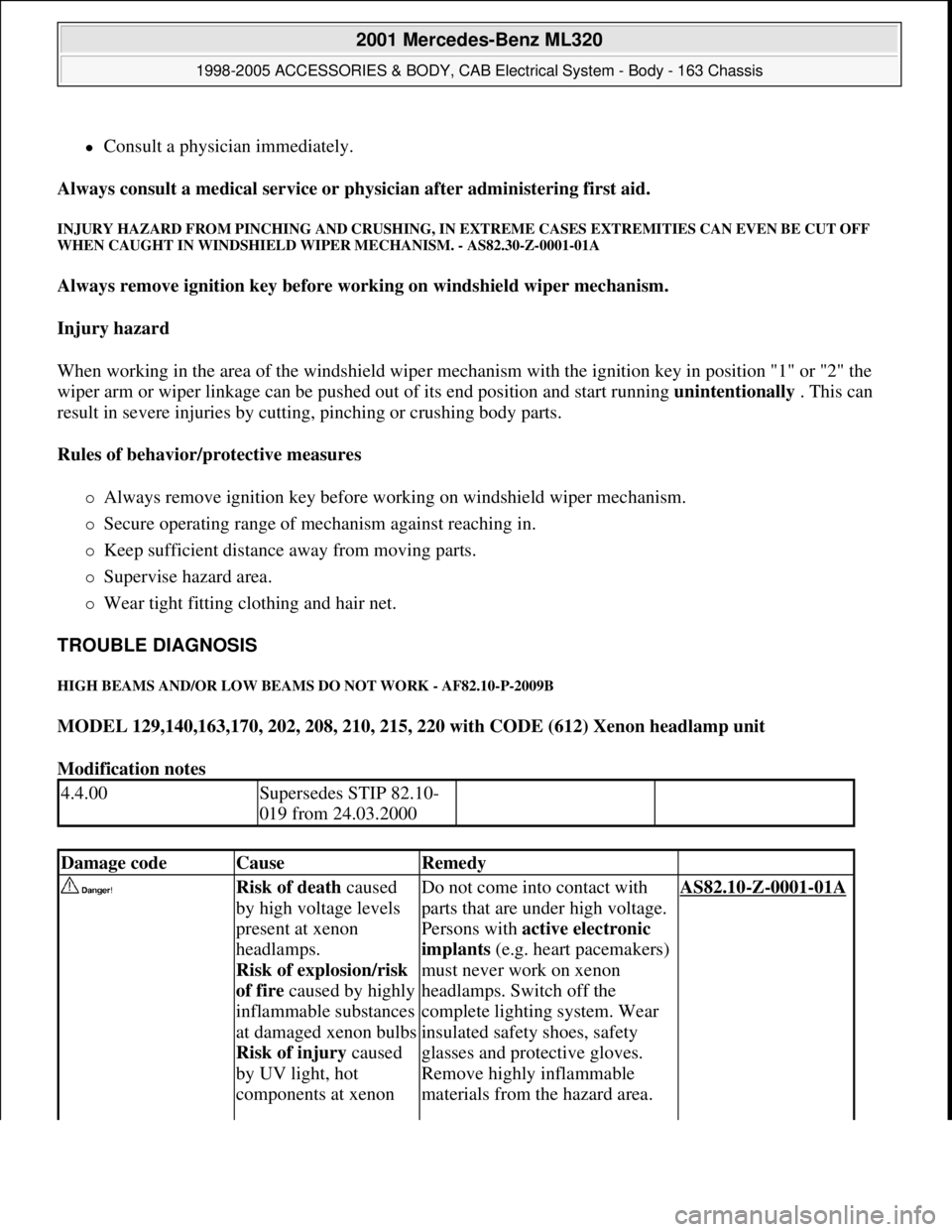
Consult a physician immediately.
Always consult a medical service or physician after administering first aid.
INJURY HAZARD FROM PINCHING AND CRUSHING, IN EXTREME CASES EXTREMITIES CAN EVEN BE CUT OFF
WHEN CAUGHT IN WINDSHIELD WIPER MECHANISM. - AS82.30-Z-0001-01A
Always remove ignition key before working on windshield wiper mechanism.
Injury hazard
When working in the area of the windshield wiper mechanism with the ignition key in position "1" or "2" the
wiper arm or wiper linkage can be pushed out of its end position and start running unintentionally . This can
result in severe injuries by cutting, pinching or crushing body parts.
Rules of behavior/protective measures
Always remove ignition key before working on windshield wiper mechanism.
Secure operating range of mechanism against reaching in.
Keep sufficient distance away from moving parts.
Supervise hazard area.
Wear tight fitting clothing and hair net.
TROUBLE DIAGNOSIS
HIGH BEAMS AND/OR LOW BEAMS DO NOT WORK - AF82.10-P-2009B
MODEL 129,140,163,170, 202, 208, 210, 215, 220 with CODE (612) Xenon headlamp unit
Modification notes
4.4.00Supersedes STIP 82.10-
019 from 24.03.2000
Damage codeCauseRemedy
Risk of death caused
by high voltage levels
present at xenon
headlamps.
Risk of explosion/risk
of fire caused by highly
inflammable substances
at damaged xenon bulbs
Risk of injury caused
by UV light, hot
components at xenon Do not come into contact with
parts that are under high voltage.
Persons with active electronic
implants (e.g. heart pacemakers)
must never work on xenon
headlamps. Switch off the
complete lighting system. Wear
insulated safety shoes, safety
glasses and protective gloves.
Remove highly inflammable
materials from the hazard area. AS82.10-Z-0001-01A
2001 Mercedes-Benz ML320
1998-2005 ACCESSORIES & BODY, CAB Electrical System - Body - 163 Chassis
me
Saturday, October 02, 2010 3:30:06 PMPage 165 © 2006 Mitchell Repair Information Company, LLC.